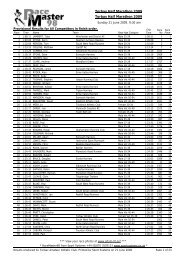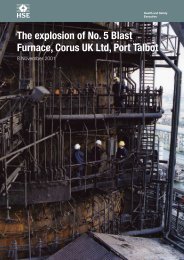A cArbon cApture And storAge network for yorkshire And humber
A cArbon cApture And storAge network for yorkshire And humber
A cArbon cApture And storAge network for yorkshire And humber
Create successful ePaper yourself
Turn your PDF publications into a flip-book with our unique Google optimized e-Paper software.
This study presents a cost, as opposed<br />
to a revenue model. There<strong>for</strong>e, it is not<br />
linked to the European Emissions Trading<br />
Scheme price of CO2 or financing of the<br />
investment in the transport infrastructure.<br />
In addition the commercial rate paid by<br />
an emitter will depend on how quickly<br />
the <strong>network</strong> grows and how ownership<br />
of the <strong>network</strong> is managed. Of particular<br />
importance is the financial cost of the timing<br />
difference between expenditure in transport<br />
infrastructure and revenue from transporting<br />
CO2. For example an early plant unable<br />
to share a transport pipeline and linked to<br />
one store will have high costs, but strategic<br />
coordination of capture plant, pipelines and<br />
equipment with shared offshore storage will<br />
reduce costs.<br />
The ability to develop a cluster of large<br />
capture sites and suitable storage<br />
sites will be the key to a successful<br />
<strong>network</strong>. Depleted gas reservoirs must<br />
be decommissioned to be available <strong>for</strong><br />
use as CO2 storage sites. The study area<br />
compactly offers a timely combination of<br />
these opportunities as shown in figure 1.2.<br />
The study recommends that Yorkshire<br />
Forward and other regional bodies promote<br />
the development of a cluster of carbon<br />
capture ready industrial sites to be an early<br />
material action to justify investment in an<br />
efficient CO2 transport and storage system,<br />
driven by the co-operation by the capture<br />
site organisations and regional bodies.<br />
The UK government clarifies a process <strong>for</strong><br />
funding support through an appropriate<br />
mechanism to facilitate investment in this<br />
clustered approach to CCS deployment.<br />
<strong>And</strong> that Yorkshire Forward commissions<br />
a cost benefit analysis to understand the<br />
wider economic, social and environmental<br />
enhancements that would arise from a<br />
region wide CCS <strong>network</strong>.<br />
In conclusion this study has evolved the<br />
work of the North Sea Basin Task Force by<br />
focusing on a key region by considering in<br />
some detail the CO2 transport component<br />
of a regional CCS <strong>network</strong>. The study<br />
provides realistic costs <strong>for</strong> consideration by<br />
government, regional bodies and industry<br />
when planning <strong>for</strong> the strategic options to<br />
significantly reduce CO2 emissions in the UK<br />
through the development of carbon capture<br />
and storage.<br />
Carbon Capture and Storage Network 5<br />
Figure 1.1 Schematic of possible CCS systems<br />
Reproduced courtesy of the IPCC from IPCC Special Report on<br />
carbon dioxide capture and storage, page 4 Fig SPM.1<br />
Figure 1.2 Emitters and storage possibilities in the Humber

















